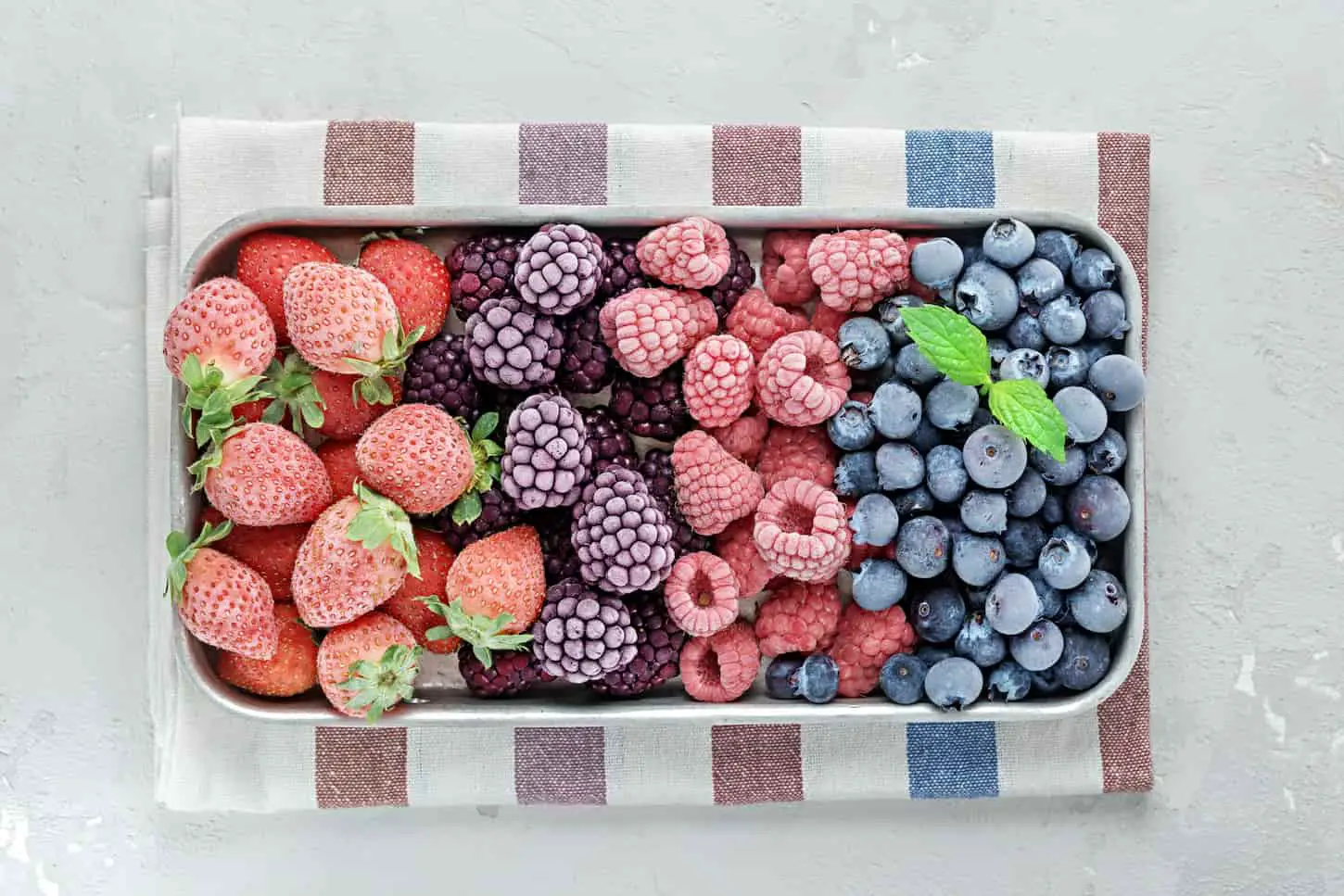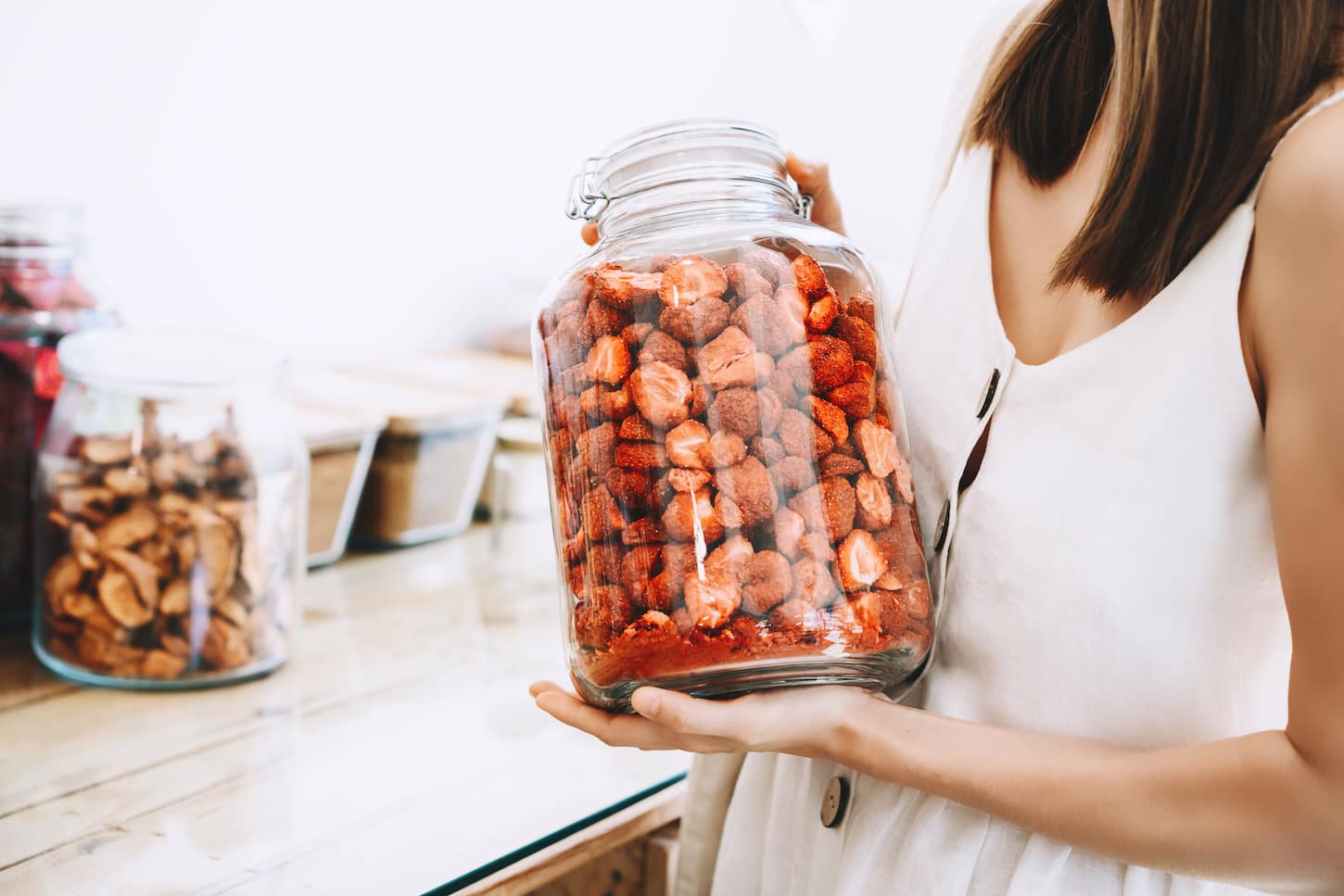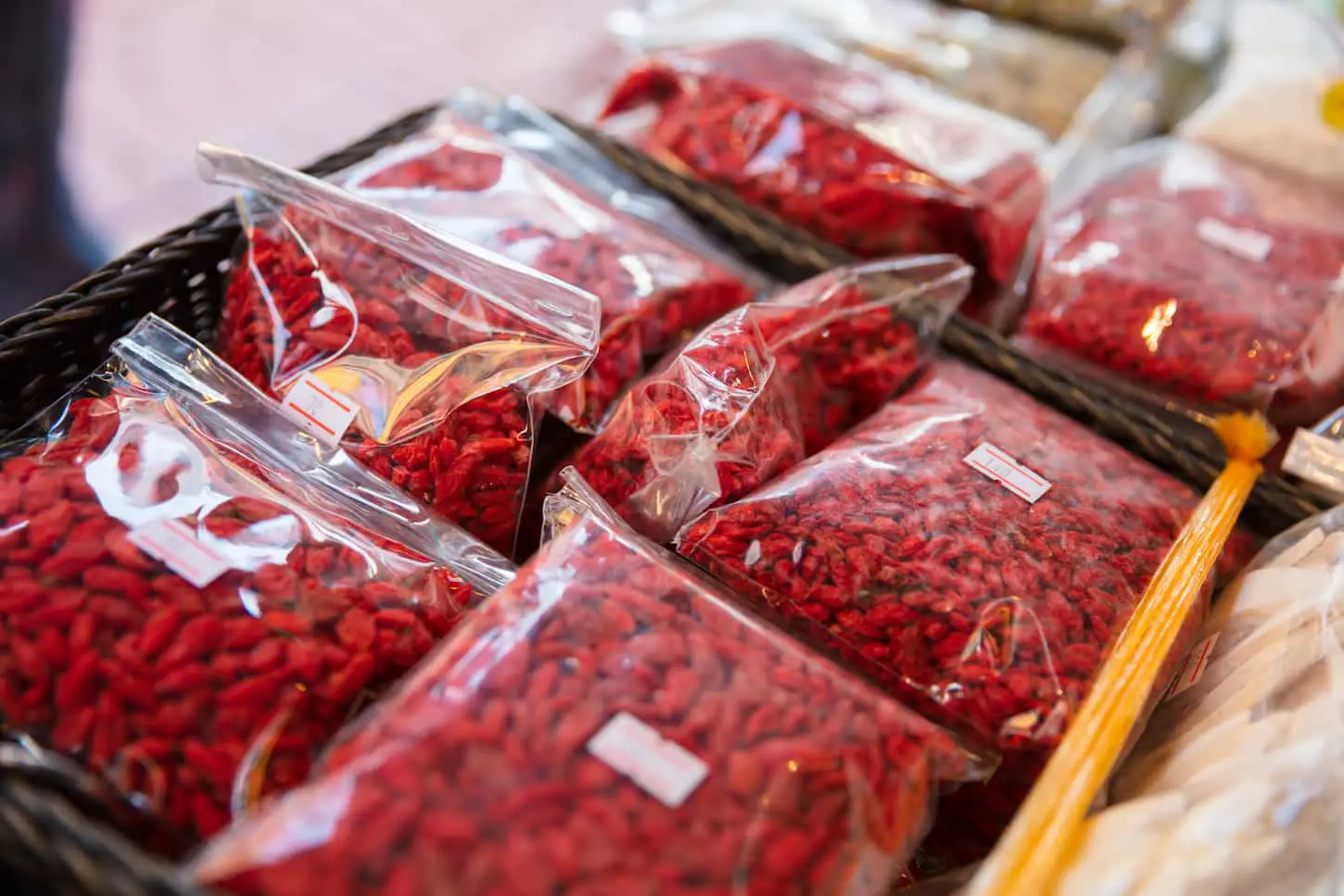If fresh berries aren’t going to be used right away, we must store them properly; otherwise, they’ll go bad. The best and safest ways to store berries for both long and short-term are different, and they need to be stored the right way depending on when we’ll use them.
Short-term berry storage methods are straightforward, but long-term storage is sometimes more complex. The best way to store berries short-term includes leaving them on the counter or in the fridge. Long-term berry storage options include freezing, dehydrating, canning, and freeze-drying.
Best Short-term berry storage
- Countertop storage: up to 24-ish hours
- Refrigeration: up to 1-2 weeks
Long-term berry storage
- Freezing: up to a year
- Dehydration: up to several years or more
- Canning: up to several years
- Freeze-drying: up to 25+ years
Read on to learn how to use these methods, precisely how they work, and how long we can store our berries!

What Is The Best Way to Store Berries?
The best way to store berries depends on how and when they will be used; berries that will be eaten or used soon can be refrigerated or stored on a countertop, while berries for jams can be frozen or freeze-dried until ready to be turned into jam.
In principle, we can only store berries for the short or long term. The best short-term way of storing berries is by refrigeration, while the best long-term way to store berries is to freeze them or freeze-dry them.
Let’s take a more in-depth look.
Short-term storage of berries
Regarding short-term storage, we can keep berries in the fridge or leave them out on the countertop. There are slight time differences, so let’s compare.
Countertop: 24 hours
There’s nothing wrong with leaving berries out if we plan to eat them soon. They can stay out for about 24 hours before they spoil, so if we buy them in the afternoon and plan to eat them after dinner – we can leave them out.
If you’re not planning on eating the berries on the same day, put them in the fridge.
A few things have to be said, though. First, berries are okay to be left out at room temperature, but higher temperatures will make them go bad quickly.
Secondly, if we leave berries outside, insects (especially fruit flies) will likely start congregating on them. So, it’d be best to leave them indoors, not outdoors.
Want to know more about leaving your berries out? Read our answer here: Can Berries Be Left Out at Room Temperature?
Refrigerator: up to 1-2 weeks
A fridge can keep berries unspoiled for a long time. As long as the temperature is below 40°F, berries can last up to two weeks in the fridge.
This depends on the berries’ freshness and variety, so keep that in mind when calculating the time. Strawberries, for example, are the exception to this rule. They don’t last as long in the fridge as other berry types.
Keeping berries at such a low temperature prevents bacteria and mold from developing quickly. Mold is especially common with berries, so we need to give them a vinegar bath before sticking them in the fridge (more on this later).
All in all – refrigeration is the storage option we should use if we’re keeping them for more than 24 hours but less than a week or two.
Wondering When Should You Store Berries In the Fridge? Our answer has you covered.

Long-term storage of berries
The best methods of long-term storage are freezing, dehydration, canning, and freeze-drying. While they’re all good options for preserving berries, they significantly affect the taste and structure of the fruit itself.
Freezer: up to 1 year (maybe more)
According to the Institute of Agriculture and Natural Resources of the University of Nebraska (now, that’s a mouthful), we can keep berries in the freezer for up to a year.
However, they might not go bad depending on the freezer settings and how well they are stored. I’ve kept several kinds of berries in vacuum-sealed bags in my freezer for up to 2-3 years, and they’ve been fine. Now, I’ve only ever used old, frozen fruit like those in jams, preserves, syrups, or smoothies. They do great like that! I wouldn’t use them like I would fresh fruit, though.
Although we’ll seriously break this down later, vapor-proof containers (or vacuum-sealed containers) achieve the best results.
As to the mechanics of freezing, here’s how it works. Freezing primarily affects the water within foods, but it does freeze anything with a similar freezing point. Most microorganisms that would otherwise spoil the food are frozen with the fruit, as they typically do best at room temperature. This doesn’t kill the organisms but prevents them from moving and growing.
To work properly, the freezer’s temperature must be below freezing, though 0°F or lower works best.
Here’s How to Freeze Berries the Right Way. That way, you can keep them stored for as long as possible.
Dehydrated: up to several years (or more)
I’m not sure if you knew this, but they didn’t have refrigerators a few thousand years ago, and dehydration was, at the time, the best storage option. Nowadays, we can buy dried food (popular with preppers) or dry our own.
The good thing about dried fruits is that their shelf life is amazing! Some manufacturers report a 25-year-long shelf life, according to Utah State University. We probably won’t reach those exact numbers on our own, but something similar should be possible.
According to the National Center for Home Food Preservation (yes, such a thing exists), home-dried fruits can be stored safely for up to a year. However, this vastly depends on the conditions around storage and the condition of the fruit being stored.
If air or moisture starts to get to the fruit – they probably won’t last long. But in ideal conditions, with perfect preservation, dried foods will most likely outlast a year.
The downside is that dried foods of all kinds, berries included, have a specific taste that many people don’t like. For example, I love the taste of several dehydrated fruits, like strawberries and raspberries. I’m not too fond of dehydrated bananas, though. I know.
That’s when it can be fun to make fruit leather! (I’m not too fond of banana fruit leather, either.)
Fruit leather, essentially candy, can last several years if stored properly.
Canned: up to 2 years or more
Canned food always refers to food canned in liquid – not dry, canned food. We need to know right off the bat that industrially canned foods last longer than home-canned foods, but that doesn’t mean that home canning won’t hold its own ground.
A rule of thumb is that home-canned foods should be used within 24 months (provided they are kept in a dark, cool place).
After that much time, it’s normal for the food to get a bit brown, become a bit soft, and even for the liquid to evaporate. This is completely normal and happens mostly because of oxidation – the food is still safe to consume.
I probably shouldn’t admit to eating home-canned goods with a label date of almost 20 years old, but I have. And, spoiler alert: I’m still here. However, I knew it was a calculated risk. I wouldn’t take that risk again unless it were something I’d canned and stored myself.
Freeze-dried: up to 25+ years
The best thing about freeze-drying food is that it sucks up 99% of the oxygen and moisture in the materials, making it almost impossible for the food to go bad. Because of this, it’s often considered to be the absolute best process for long-term storage.
Some sources say freeze-dried food should be good for about 25 years. This is just a theory, though, as the first home freeze-dryer was invented in about 2013, and quite honestly, we have no idea what’s the actual shelf life of home freeze-dried goods. However, it’s probably a pretty solid theory, as freeze-drying is a process that’s been around in its more current form since the early 1900s, and earlier variations of freeze-drying date back to the times of the Incan empire.
There’s also evidence it could be safe for more than 25 years, as I’ve read various studies put out by people who test old, freeze-dried army meals and find that they’re still fine to eat even after several decades. I’ll need to find those links, but it is something I’ve read.
TLDR: Freeze-drying has the potential for the longest shelf-life of all the methods described in this article.
| Method | Shelf-Life | Costs |
|---|---|---|
| Countertop storage | about 24 hours | free to cheap |
| Refrigerator | up to 1-2 weeks | you need a fridge; it could be pricey |
| Freezer | up to 12 months or more | you need a freezer; it could be pricey |
| Dehydrated | up to 12 months or more | cheap to about $300, depending on what you use |
| Canned | up to 24 months or more | getting started could cost several hundred, but if you have canning gear, then jars and lids are pretty cheap* |
| Freeze-dried | up to 25+ years | a freeze-dryer can cost several thousand dollars, depending on the model and accessories* |
Dehydrator notes:
- Want to know if it’s worth getting a dedicated dehydrator or if you should use an oven? Read our guide: Dehydrating in an oven vs. a dehydrator.
- Don’t have a budget for a dehydrator yet? No worries. Please read our article on dehydrating food without a dehydrator.
- Want to get the best dehydrator possible? In our opinion, it’s the Excalibur Dehydrator.
Freeze dryer notes:
- If you want a solid breakdown of how much a freeze-dryer costs upfront, read our guide here: Why are Freeze Dryers So Expensive? Are They Worth it?
- If you’d like a breakdown of how much it costs to run a freeze-dryer, read this How Much It Costs To Run A Freeze Dryer: The Complete Guide.
- Want to get the best freeze dryer? It’s the Harvest Right brand, though which size you need will depend on your circumstances. We have the medium.
Ready to freeze-dry some berries already? Here’s your DIY tutorial: Freeze Drying Berries: How-to and FAQs Answered!

How Do You Make Berries Last Longer?
To make berries last longer, they can be frozen, dehydrated, canned, or freeze-dried. Each method has a different storage timeline. Berries not left out to eat should be stored in an airtight container, and may also need to be vacuum-sealed or have an oxygen absorber. Shelf-stable options should be stored in a cool, dry environment.
Here are links to properly preparing and storing berries, depending on how you want to prepare them.
| Method | Link to our article or guide |
|---|---|
| Countertop | Can Berries Be Left Out at Room Temperature? |
| Fridge | When Should You Store Berries In the Fridge? |
| Freezer | How to Freeze Berries the Right Way |
| Canned | Canning Berries Complete How-To and Practical Guide |
| Dehydrated | Dehydrating Berries: How-to Guide with FAQs |
| Freeze-dried | Freeze Drying Berries: How-to and FAQs Answered |

Storing Berries FAQs
Frequently Asked Questions
We’re here to help! Check out our FAQs section below for answers to common questions. If we missed yours, let us know, and we’ll update the article. Contact us through our website, and we’ll respond directly to your question.
Do you ever need to wash berries in vinegar?
A vinegar bath is recommended for short-term storage to get rid of mold. Water alone won’t destroy mold, but if we make a solution that’s 3 parts water and 1 part vinegar, it will eat the mold right up. A vinegar bath may also prevent oxidation or darkening.
After that, all left to do is rinse the berries with water and store them (after drying).
Ascorbic acid is also an effective way of keeping berries from darkening from oxidation. To treat the berries, combine 34 grams of ascorbic acid crystals with 1 liter (4 cups) of cold water.
This is enough for 10 quarts of cut fruit (more or less). Soak the fruit in the solution for 10 minutes and drain well once the time has passed.
How should you store berries after washing them?
Berries that have been washed can either be left out (for up to 24 hours) to eat or prepared for long-term storage in the fridge, freezer, or other storage methods.
Lay the berries on paper towels to dry. Put them in a bowl, ziploc bag, or a covered Tupperware, and put them in the refrigerator. Please do not put them in the coldest part of the fridge, or they will get frostbite.
Can you store two types of berries together?
Nothing terrible will happen if we store different varieties of berries together – raspberries and blackberries, for example. We can keep more than two varieties of berries together if desired.
One thing to watch out for is overcrowding the container. There should always be half an inch of empty space between the top layer of the berries and the lid.
How do you store berries in Tupperware?
Use Tupperware’s airtight containers to get rid of all the oxygen in the container and prevent oxygenation. The process itself isn’t different from other storage processes. Just force the air out before closing the container completely. If you have a vacuum-sealer that attaches to Tupperware, this is a great way to get rid of excess air.

Storing Berries in Mason Jars
Mason jars are helpful for fridge storage, dehydrated or canned berries, and freeze-dried storage. Never freeze mason jars with canned berries if they are still hot, as the glass will most definitely crack. Berries in mason jars can be frozen if they aren’t hot. Clean and dry mason jars before use.
This is especially important with dehydrated berries – there can’t be any moisture inside once we close the jar. You may want to add an oxygen absorber if you want to keep them fresher longer. If you’ve got a vacuum-sealer that can attach to mason jars, go ahead and vacuum-seal them, too.
Key Takeaways and Next Steps
Long-term storage can keep berries safely stored for up to a year, potentially even longer. We should only use short-term storage if we’re going to eat the berries soon (within two weeks).
The issue with long-term storage is that, aside from the freezer, most of the equipment needed to store food is expensive. However, it’s still worth investing in if you don’t want to waste food.
Resources
Learning from your own experience is essential, but learning from others is also intelligent. These are the sources used in this article and our research to be more informed as homesteaders.
- Food and Nutrition series preparation – UGA. (n.d.). Retrieved December 7, 2022, from https://nchfp.uga.edu/how/dry/csu_dry_fruits.pdf
- Freeze drying vs. dehydrating – ivins. (n.d.). Retrieved December 7, 2022, from https://www.ivins.com/wp-content/uploads/2021/04/RCP-Freeze-drying-vs-Dehydrating-1.pdf
- “Home Food Storage.” UNL Food, 12 July 2022, food.unl.edu/free-resource/food-storage.
- “How Does Freezing Preserve Food and Maintain Quality?” Eufic, www.eufic.org/en/food-safety/article/chilling-out-freezing-foods-for-quality-and-safety.
- National Center for Home Food Preservation | How Do I? Freeze. nchfp.uga.edu/how/freeze/blueberry.html.
- University, U. S. (n.d.). Canning resources. USU. Retrieved December 7, 2022, from https://extension.usu.edu/preserve-the-harvest/food-storage
- Utah State University. “Buying a Home Freeze-Dryer: What to Know Before You Go.” USU, 27 Oct. 2022, extension.usu.edu/preserve-the-harvest/research/buying-a-home-freeze-dryer-what-to-know-before-you-go.
